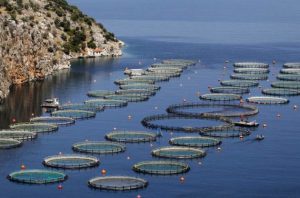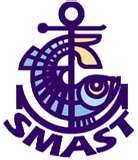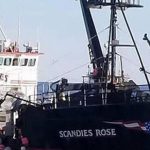Tag Archives: Wastewater Treatment Plants
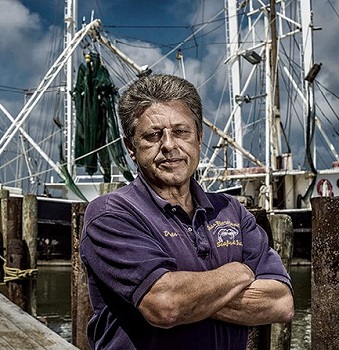
The Dead Zone – Nothing Here Gets Out Alive
With an easy drawl, Dean Blanchard, the owner of Dean Blanchard Seafood in the barrier-island town of Grand Isle, Louisiana, makes an understated observation: “There’s a reason they call it a dead zone. When the dead zone comes, everything’s dead. We can’t catch dead stuff. We’re in the live stuff business.” What Blanchard is talking about is the Gulf of Mexico “dead zone,” an enormous area in which, every spring, an overgrowth of algae and other vegetation absorbs dissolved oxygen from the water and kills all animal life. “This year,” Blanchard says, “we had shrimp jumping on the beach, committing suicide, trying to get out of the water because there’s no oxygen.” The result is an economic disaster. To find live shrimp, fishers have to ply their boats as far as fifty miles from shore. “With the price of fuel, you don’t want to go too far,” Blanchard says. His company’s annual haul has declined from twelve million pounds of shrimp a year to under five million. He used to employ sixty workers—now he’s down to thirty. >click to read< 11:49
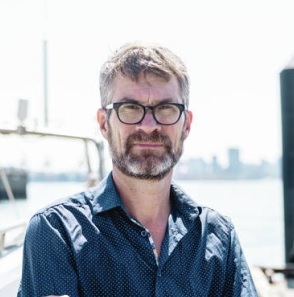
British Columbia: Pollution expert aims to create ‘water champions’
Peter Ross, an internationally recognized expert in water pollution, looks out over the sparkling waters of Burrard Inlet and sees something others do not. Invisible chemicals tend to be out of sight and out of mind, says Ross. But they leach into watercourses and into the marine food chain, creating “an invisible crisis.” “There are 500,000 chemicals on the global marketplace,” he said. Many of those will surreptitiously make their way into the food chain. Salmon heading up the Fraser River are also “basically running a gauntlet,” said Ross, “past wastewater treatment plants, past farms, past pulp mills, past refineries and storm drains.” Pollution is also an issue in drinking water,>click to read< – A global problem? 6PPD quinone: The environmental contaminant killing Coho salmon-An everyday chemical has been found to be highly toxic. Contamination of waterways is responsible for what had been the unexplained mass deaths of Coho salmon. We take a look at 6-PPD quinone, >click to read<14:39

New law ‘turns on the spigot’ at old plant that treats wastewater on Delaware River
A South Jersey company could soon again be processing millions of gallons of hazardous wastewater and dumping the residue into the Delaware River thanks to a bill signed into law by Gov. Phil Murphy. The measure updates the definition of what an existing hazardous waste facility is under state law, basically grandfathering in Chemours’ wastewater treatment plant in Carneys Point, enabling it to possibly resume again accepting outside waste to treat. During the multi-step process, solids are removed and the cleaned water is dumped into the nearby Delaware River. >click to read<08:58
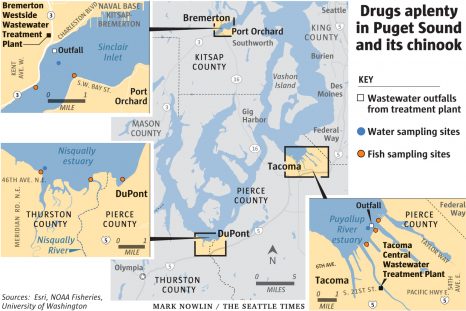
Puget Sound salmon do drugs, which may hurt their survival
Anti-depressants. Diabetes drugs. High-blood-pressure medication. Puget Sound chinook are doing our drugs, and it may be hurting them, new research shows. The metabolic disturbance evident in the fish from human drugs was severe enough that it may result not only in failure to thrive but early mortality and an inability to compete for food and habitat. The research built on earlier work, published in 2016, that showed juvenile Puget Sound chinook and Pacific staghorn sculpin are packing drugs including Prozac, Advil, Benadryl, and Lipitor among dozens of other drugs present in tainted wastewater discharge. >click to read<12:50

“ammonium” – San Francisco’s love affair with Dungeness crab grows more toxic
According to a new study published by researchers at San Francisco State University, wastewater pollution also makes our relationship with Dungeness crabs more toxic. Waste doesn’t disappear with a flush. In San Francisco, wastewater from homes and streets drains to treatment facilities operated by the San Francisco Public Utilities Commission. The facilities clean the water according to federal and state standards. But a form of nitrogen, called “ammonium,” remains when SFPUC releases the water into the Bay and Pacific Ocean. >click to read< 09:05

Florida’s building boom threatens wildlife-rich lagoon
The most biologically diverse waterway in America is seriously ill. The Indian River Lagoon is repeatedly being choked with oxygen-robbing algae, its surface increasingly dotted with thousands of dead fish, manatees, birds and other creatures. The culprits: farm runoff and a huge influx of people that has sent lawn fertilizer and other pollutants into the lagoon, which runs 156 miles along Florida’s Atlantic Coast, almost to Palm Beach, and includes the Cape Canaveral area. “It’s the death by a thousand cuts,” said Bob Knight, an environmental scientist with the Howard T. Odum Florida Springs Institute who has studied Florida’s waters for 40 years. The lagoon’s woes threaten the region’s $2.5 billion recreation, fishing and tourism economy, alarming kayak tour operators, charter boat captains, restaurateurs and organizers of bird-watching festivals. click here to read the story 19:48
Long List of Factors Stressing Out (poisoning) Narragansett Bay
 The Narragansett Bay Estuary Program has developed a draft report on the status of Narragansett Bay entitled “State of the Bay and its Watershed.” Numerous factors, beyond climate change, sea-level rise and legacy contaminants, stress Rhode Island’s most significant natural resource. Here is a look at some of the others detailed in the NBEP’s draft report.,, Population growth, Land-use changes, Impervious surfaces, Nutrient loading, Chemical contaminants of emerging concern (CECs). They include but aren’t limited to nonprescription and prescription pharmaceuticals, personal-care products, and industrial chemicals used in a wide range of consumer, commercial and industrial products. Some examples: antidepressants, antihypertensives, antibiotics, painkillers and synthetic hormones; antimicrobials such as Triclosan; UV blockers in sunscreens such as oxybenzone; DEET, a pesticide which is applied to human skin; fragrances such as synthetic musks; flame retardants such as polybrominated diphenyl ethers; additives to plastics; and synthetic materials such as bisphenol A, commonly referred to as BPA. click here to read the story 16:53
The Narragansett Bay Estuary Program has developed a draft report on the status of Narragansett Bay entitled “State of the Bay and its Watershed.” Numerous factors, beyond climate change, sea-level rise and legacy contaminants, stress Rhode Island’s most significant natural resource. Here is a look at some of the others detailed in the NBEP’s draft report.,, Population growth, Land-use changes, Impervious surfaces, Nutrient loading, Chemical contaminants of emerging concern (CECs). They include but aren’t limited to nonprescription and prescription pharmaceuticals, personal-care products, and industrial chemicals used in a wide range of consumer, commercial and industrial products. Some examples: antidepressants, antihypertensives, antibiotics, painkillers and synthetic hormones; antimicrobials such as Triclosan; UV blockers in sunscreens such as oxybenzone; DEET, a pesticide which is applied to human skin; fragrances such as synthetic musks; flame retardants such as polybrominated diphenyl ethers; additives to plastics; and synthetic materials such as bisphenol A, commonly referred to as BPA. click here to read the story 16:53
Fish found in Washington’s Puget Sound are tripping on cocaine, Prozac, Advil, Benadryl, and Lipitor.
 Unfortunately, there is no aquatic drug dealer responsible for it. Instead, the intoxication is the result of tainted discharge water. Pharmaceutical pollution could be to blame for the many drugs showing up in the tissues of juvenile Chinook salmon. Estuary waters near the sewage treatment plants were found to contain a cocktail of up to 81 different drugs, according to a new study out of the National Oceanie and Atmospheric Administration (NOAA). There are several plausible theories about the Puget Sound’s high concentration of . Jim Meador, an environmental toxicologist at the NOAA’s Northwest Fisheries Science Center in Seattle, published a study that offered two options. Read the rest here 14:03
Unfortunately, there is no aquatic drug dealer responsible for it. Instead, the intoxication is the result of tainted discharge water. Pharmaceutical pollution could be to blame for the many drugs showing up in the tissues of juvenile Chinook salmon. Estuary waters near the sewage treatment plants were found to contain a cocktail of up to 81 different drugs, according to a new study out of the National Oceanie and Atmospheric Administration (NOAA). There are several plausible theories about the Puget Sound’s high concentration of . Jim Meador, an environmental toxicologist at the NOAA’s Northwest Fisheries Science Center in Seattle, published a study that offered two options. Read the rest here 14:03Wastewater Treatment Plants: Pharmaceutical fish – SCSU experiments
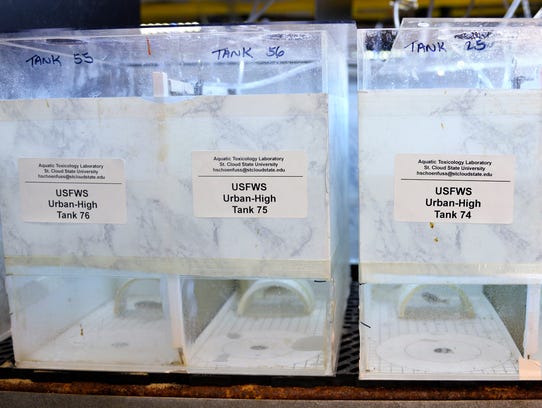
They say The Sky isn’t Falling. I disagree! The sky has fallen, and Fishermen are paying for it. Pharmaceuticals in our water
 There’s no way around it, the headlines are disturbing. They describe fish and birds responding with altered behavior and reproductive systems to antidepressants, diabetes medication, and other psychoactive or hormonally active drugs at concentrations found in the environment. About 90% of pharmaceuticals found in the environment arrive there after being excreted. Wastewater treatment plants, meanwhile, are exploring possibilities for boosting their ability to remove pharmaceuticals from sewage. Read the rest here 13:49
There’s no way around it, the headlines are disturbing. They describe fish and birds responding with altered behavior and reproductive systems to antidepressants, diabetes medication, and other psychoactive or hormonally active drugs at concentrations found in the environment. About 90% of pharmaceuticals found in the environment arrive there after being excreted. Wastewater treatment plants, meanwhile, are exploring possibilities for boosting their ability to remove pharmaceuticals from sewage. Read the rest here 13:49
As Our Oceans Degrade, The Environmentalist Network Stays Focused on their Overfishing Bread and Butter
![]()
Canadian scientists warn of artificial sweeteners in oceans. It means that up to 72 metric tonnes (160,000 pounds) of sweetener are pouring into Lake Erie. Because the sweeteners — used in products like diet soda, chewing gum, yogurt and as sugar replacements in tea and coffee to avoid weight gain — cannot be broken down by the human body, the artificial sweeteners pass right through. They cannot be broken down by wastewater treatment plants either, meaning the undiluted sweeteners enter the water supply used as drinking water for humans and animals. Read the rest here 10:08
Wastewater Treatment Plants – Why we can’t get our water supply free of drugs.
Vance Trudeau, a biologist at the University of Ottawa, who has found evidence of “sexual side effects” in goldfish exposed to traces of Prozac in his lab, says “Prozac is the tip of the iceberg.” He adds that U.S. waterways are becoming a and he, along with Writer and other biologists, say that soup is becoming more difficult to identify and filter everyday. “Most sewage treatment plants have not been built with the removal of pharmaceuticals in mind because it wasn’t something people were thinking about,” Trudeau says. “To upgrade is prohibitively expensive. So pretty much anything we take ends up in the water.” Read the rest here 23:01






 A comprehensive study of a major California estuary has documented the links between nutrient runoff from coastal land use, the health of the estuary as a nursery for young fish, and the abundance of fish in an offshore commercial fishery. The study, published the week of June 8, 2015, in Proceedings of the National Academy of Sciences, focused on Elkhorn Slough and Monterey Bay on California’s central coast. ” is nitrogen, whether it comes from an agricultural field or sewage or urban runoff.
A comprehensive study of a major California estuary has documented the links between nutrient runoff from coastal land use, the health of the estuary as a nursery for young fish, and the abundance of fish in an offshore commercial fishery. The study, published the week of June 8, 2015, in Proceedings of the National Academy of Sciences, focused on Elkhorn Slough and Monterey Bay on California’s central coast. ” is nitrogen, whether it comes from an agricultural field or sewage or urban runoff. 




























